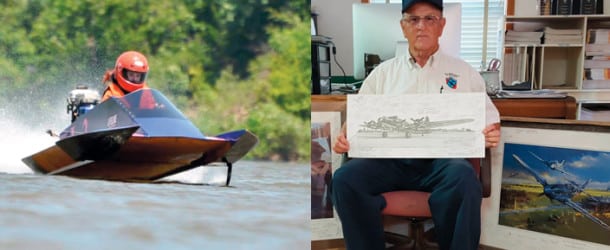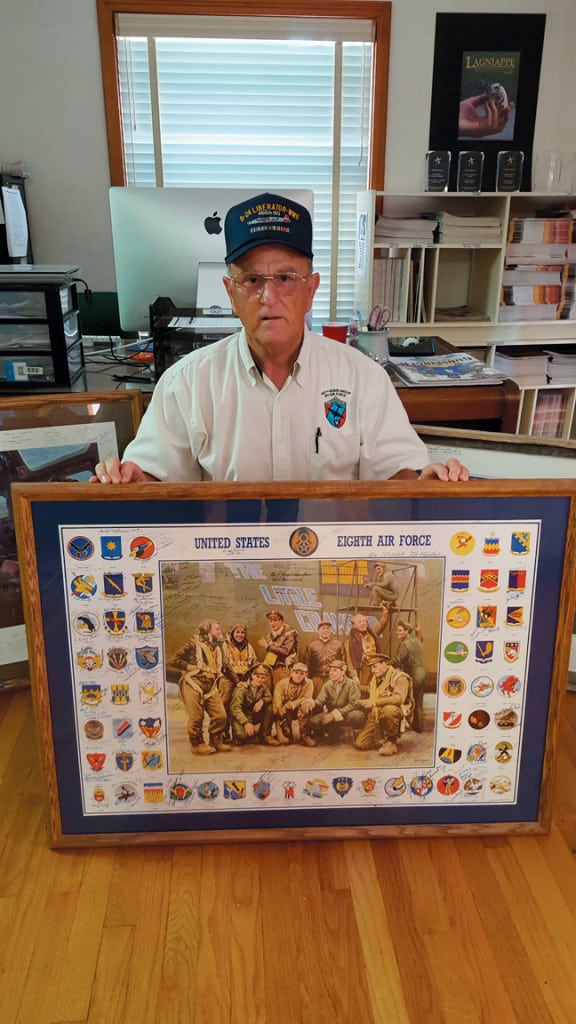Two Local Residents Collect Historic, Antique Items
By Karla Wall
Collectors become obsessed with gathering the items they value — be it potholders, stuffed animals, rare vehicles or weapons — for many reasons: sentimentality, aesthetics.
But for two local residents, collecting is a way to keep the past alive.
Harry Tanner: Keeping Them Flying
Lagniappe first introduced readers to Harry Tanner in 2006, when it profiled his quite extensive collection of WWII aviation memorabilia.
Tanner’s always been a collector, he says; as a young boy, he had an impressive autograph collection, which he started when, at a horse show with his father, he got the autograph of 1950s western star Dale Robinson. He went on to collect sports memorabilia, and has several autographed pictures of Mickey Mantle, Yogi Berra, and many others. He has numerous six-inch binders filled with index cards with autographs from sports stars (Nancy Kerrigan; Billy Andrews, the Baton Rouge native who was the first player to score on Monday Night Football), rodeo stars, politicians and actors.
“I’d just send (celebrities) an index card and a return envelope, and they’d send the cards back signed,” Tanner says.
But, as a long-time airplane enthusiast, it’s Tanner’s WWII aviation collection that holds his interest now.
When I visited Tanner in ‘06, he showed me a just-delivered 6-foot replica of the P-51 Mustang plane Jersey Bounce, a plane flown by Lt. Mahoney of the 55th Fighter Group of the 8th Air Force. The replica had a 5-foot wingspan, and Tanner was keeping it in the garage at that time, though he thought he’d set aside enough room for it in the living room — on the coffee table.
“It turned out to be just a bit bigger than I thought it would be,” he grinned.
Tanner’s collection is too extensive for a complete rundown. There are binders full of autographs from aviation heroes from the war — WWII aces (those pilots who shot down five or more enemy aircraft), even German pilots and officers. There are binders filled with notes from pilots and engineers (including Pappy Boyington of the famed Black Sheep Squadron); written histories of planes, battles and pilots; biographies; maps and photos (one of the Enola Gay, which dropped the world’s second atomic bomb on Nagasaki, Japan).
He also has an original “scoreboard” from a squad command center; it still has the marks on it outlining the outcome of missions. There’s also an original escape map, one of which was sewn into the lining of every pilot’s flight jacket, highlighting escape routes in case of trouble. He also has several uniforms, some complete with medals.
“(Collecting) is like a full-time job for me,” Tanner quipped.
It’s an effort that’s earned Tanner some national recognition, and membership in some pretty elite historical societies, some not normally open to civilian history buffs. He’s served as secretary and president of the 8th Air Force Historical Society (and is founder and president of the group’s Louisiana chapter); a member of the P-40 Warhawk Pilot’s Assoc.; a life member of the 15th Air Force Assoc.; and a member of the A-1 Sky Raiders Assoc.
He lectures at schools and air force group reunions, and is considered quite an authority. In fact, he says, he receives many letters and emails from former squad members, and families of members, looking to find information on friends or family members who flew in the war.
Serving as an officer in many of the historical groups he’s involved with, Tanner travels quite a bit to reunion meetings of squad members and historical societies, and those travels have given rise to his new focus: autographed framed group photos of fighter squads.
“I attend 25-30 reunions a year, from San Antonio to Washington, D.C., to St. Louis to Atlanta,” Tanner says.
He takes along prints of original paintings of the squads he visits, and has members autograph them. He now has 25-30 completely autographed, 24-inch-by-33-inch framed prints.
And he’s not selfish with his collection. He has donated prints to be displayed in a Sulphur barber shop, as well as several restaurants throughout the state.
Tanner’s collection now numbers about 40,000 items, and its importance is brought home as he shows me a few of the prints, pointing out the names of people who’ve recently passed away. The history of WWII won’t be a living one much longer.
“It’s fading fast,” Tanner says. “All of these men are dying off.”
Alan Van Weele: Beauty, History And Speed
Moss Bluff resident Alan Van Weele doesn’t like a slow pace. His retirement years have consisted not of taking it easy in the backyard hammock, but tinkering with, caring for and driving his collection of ultimate muscle cars — a few Dodge Vipers, as well as a Viper pickup; and most of his time is devoted to his and his family’s hobby and passion: high-speed boat racing, and his collection of antique boat motors.
Van Weele’s been a boat racing enthusiast since he was a boy, growing up in New York. In 1955, then in his late teens, Van Weele went against his parents’ wishes and bought a Speedliner M510 Corsair race boat and raced it using a 1955 Mercury Mark 20H motor.
“My dad actually bought me my first motor in 1953,” Van Weele says. “It was a 16-horsepower motor to be used for water skiing. He didn’t want me to race. He thought it was too dangerous.”
Van Weele managed to hide his racing boat and motor from his parents for a time (until his mother found them stashed in the attic while spring cleaning), and he had a successful race career in the Northeast, both in “sprint” races of about three miles, and longer routes of 88 miles or more, on the Lawrence River and around Manhattan Island. His brother joined him in the hobby, racing his own boat, a Sid Craft, powered by a KgH4 motor.
Nowadays, Van Weele is content to travel with his son, Alan, Jr., and his granddaughter, Kaylee, age 19, who are carrying on the family tradition. Son Alan, Jr., is currently third in the country in the D Stock Hydro racing division.
Kaylee, Van Weele says, is currently in her third year of racing, and is ranked third in the nation in C Stock Hydro division; she’s ranked second in the A Stock Hydro division.
“She has a real shot at no. 1,” Van Weele says, “with a Texas race still to go this year, and the Jacksonville, Ill., national finals.”
Kaylee, who will begin her studies at Sowela this fall, is one of only seven female racers on the NBRA circuit.
“All seven are really good drivers,” Van Weele says. “They’re very competitive.”
And, he adds proudly, Kaylee already has her own fan club.

“Our first race will be next spring,” Van Weele says.
But, as much time and effort as Van Weele devotes to actual racing, he also finds time for his collecting hobby. He now has, he estimates, close to 100 antique outboard motors, all Mercury engines, all made from 1952-1984.
A Mercury dealer for several years in New York, Van Weele says he’s always been an enthusiast of the engines.
His collection includes a Mercury Mark 58 Quicksilver and a Mark 55 H 40 cc engine, as well as numerous Quincy Looper engines, manufactured in Quincy, Ill. He now has 14 of the engines intact, and a few more in parts to be rebuilt.
“When I get those put back together, I’ll have one of the largest collections of Quincy Loopers in the country,” Van Weele says.
There’s a KF-9 in Van Weele’s collection. The motor was the first four-cylinder engine produced by Mercury, and was manufactured in the late 1940s and early 1950s.
He has a 75-hp Mercury Mark 40 H, one of only 26 made. There’s also a Mercury Mark 55 H, which Van Weele built himself from parts, and a Mercury Mark 50, one of only 1,000 produced during the one year it was made.
But his pride and joy? A never-cranked, showpiece 1956 Mercury Mark 28, identical to the one Van Weele owned when he was 16. Van Weele acquired the motor last summer from a dealer in St. Charles, Minn., and it now sits in a glass display case in Van Weele’s home.
Boats, cars, trucks, motors … as you might imagine, Van Weele’s hobbies have outgrown the backyard shed and garage. He’s now in the process of moving his collection to a 5,000-square-foot “hobby shop” on Hwy. 171, near the new boat launch.
“It’s part workshop, part museum, part woodworking shop … it houses most of my toys,” Van Weele says.
The move to the new building should be completed, he adds, when the racing season is over in a couple of months.



















Comments are closed.